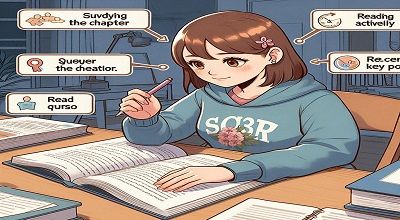SQ3R Study Method
SQ3R is a reading comprehension and study method designed to help students engage with and understand academic texts more effectively. The acronym SQ3R stands for:
- Survey: Before diving into the details of a text, quickly survey the material. Look at headings, subheadings, bolded or italicized text, and any visual elements (charts, graphs, images). This gives you a preview of the content and structure.
- Question: Formulate questions based on the information gathered during the survey phase. What do you expect to learn from the text? This step encourages active thinking and helps you set a purpose for your reading.
- Read: Read the material carefully while keeping your questions in mind. Focus on understanding the main ideas and supporting details. Take notes, highlight key points, and try to relate the information to your questions.
- Recite: After completing a section of the text, close the book or look away and try to recall the main ideas and key details. This step helps reinforce your understanding and retention of the material.
- Review: Regularly review the material you’ve read. This can involve going back over your notes, reciting key points, and testing your understanding with your formulated questions. Reviewing helps to solidify your knowledge and prepares you for assessments.
SQ3R is a systematic approach that encourages active engagement with the material, helping students to comprehend and retain information more effectively. It is often used as a study technique for textbooks and other academic materials.
SQ3R: A Definition For Teachers
For teachers, SQ3R is a methodical reading and study strategy that can be introduced to students to enhance their comprehension and retention of academic content. The acronym SQ3R stands for Survey, Question, Read, Recite, and Review, and each step in this approach plays a specific role in the learning process.
- Survey: Encourage students to start by surveying the material before delving into a detailed reading. This involves skimming through headings, subheadings, and any visual aids to gain an overview of the content. Teachers can guide students to pay attention to the structure of the text and any cues that may help them understand the main ideas.
- Question: Help students formulate questions based on the information they gather during the survey. This step encourages critical thinking and provides a purpose for reading. Teachers can guide students by generating questions that target the main concepts and details they should focus on while reading.
- Read Instruct students to read the material carefully, keeping their formulated questions in mind. Teachers can emphasize the importance of understanding the main ideas, supporting details, and the overall message of the text. Guiding effective reading strategies, note-taking, and active engagement with the content is essential during this step.
- Recite: After reading a section, guide students to close the book or look away and try to recite or recall the main ideas and key details. This step reinforces learning through active retrieval, helping to solidify understanding. Teachers can encourage students to use their own words to express what they’ve learned.
- Review: Stress the importance of a regular review to enhance long-term retention. Teachers can guide students in revisiting their notes, reciting key points, and self-quizzing based on the formulated questions. This step helps students reinforce their learning, identify areas that may need further clarification, and prepare for assessments.
Final Words
By incorporating SQ3R into their teaching practices, educators provide students with a structured approach to reading and studying, fostering better comprehension and academic success. The method encourages active participation and critical thinking, helping students become more independent learners.
